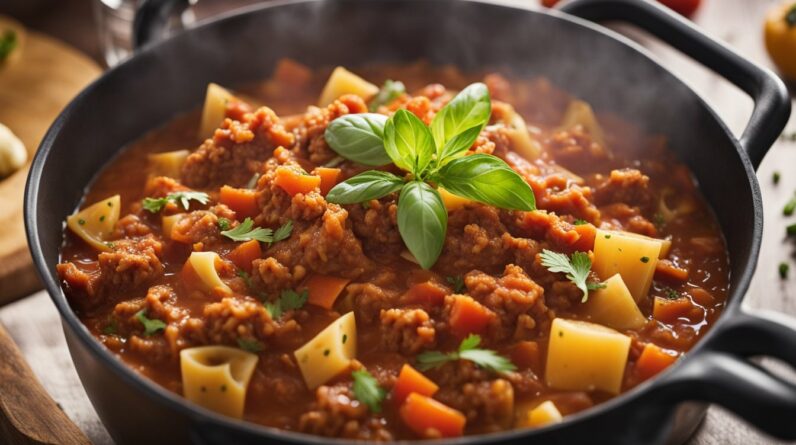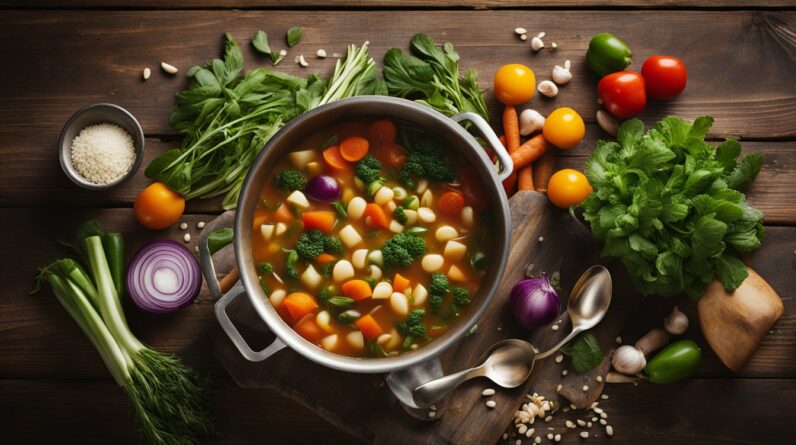Have you ever wondered about the origins of the deliciously tangy and flavorful pickled vegetables that often accompany your favorite Italian dishes? In this article, we will take you on a journey through time to uncover the fascinating history behind the Italian practice of fermenting vegetables. From the humble beginnings of preserving produce for long winters to the modern-day popularity of pickling, we will explore the ancient techniques and cultural significance that have shaped this culinary tradition. Join us as we explore the secrets of pickled eggplants, peppers, and more, and discover the rich heritage behind these mouthwatering treats.
1. Introduction to Italian Fermented Vegetables
What are fermented vegetables?
Fermented vegetables are a popular culinary tradition in Italy. The process of fermentation involves the conversion of sugars and carbohydrates in vegetables into acids or alcohol, resulting in a tangy and flavorful end product. This preservation technique not only extends the shelf life of the vegetables but also enhances their taste and nutritional value.
Why are they popular in Italian cuisine?
Fermented vegetables hold a special place in Italian cuisine due to their ability to add depth and complexity to dishes. Italians have long recognized the transformative power of fermentation, using it to elevate the flavors of their beloved ingredients. The balance of acidity and umami created through fermentation complements many traditional Italian flavors and is a key component in various classic recipes.
Overview of pickled eggplants and peppers
Two notable examples of Italian fermented vegetables are pickled eggplants and peppers. These vegetables, which are abundant in various regions of Italy, undergo a fermentation process that enhances their natural flavors and extends their shelf life. The tangy and slightly sweet taste of pickled eggplants, along with the spicy and smoky notes of pickled peppers, make them versatile ingredients in Italian cuisine.
Importance of fermentation in Italian food culture
Fermentation has played a crucial role in Italian food culture for centuries. It has not only provided a means of preserving vegetables before the advent of refrigeration but has also allowed Italians to create unique flavor profiles and culinary traditions. The art of fermentation has been passed down through generations, contributing to the rich tapestry of Italian gastronomy.
2. Ancient Origins of Fermentation in Italy
Historical evidence of fermentation practices in ancient Rome
The roots of Italian fermentation date back to ancient Rome, where the preservation and fermentation of vegetables were commonplace. Historical accounts and archaeological findings suggest that fermented vegetables, such as olives and pickled cabbage, were widely consumed by the Romans. These practices were not only driven by the need for food preservation but were also influenced by the Romans’ appreciation for the complex flavors that fermentation imparted.
Fermented foods in Italian monastic traditions
Italian monastic communities have played a significant role in the preservation and cultivation of traditional fermentation techniques. Monks, renowned for their expertise in agriculture and preservation, often used fermentation to extend the lifespan of vegetables. Their monastic gardens provided an abundant supply of vegetables, and fermentation offered a way to enjoy their harvest year-round.
Preservation techniques before refrigeration
Before the invention of refrigeration, preserving food was a necessity. Traditional fermentation techniques allowed Italians to enjoy the flavors of summer vegetables throughout the year. By packing vegetables in salt or brine, they could create an acidic environment that inhibited the growth of harmful bacteria, ensuring the vegetables remained safe to consume.

3. Traditional Techniques and Recipes
Harvesting and selecting the best vegetables
Italian fermentation traditions place a strong emphasis on using fresh, high-quality vegetables. The selection of the best produce is vital to achieving exceptional results. Seasonal vegetables, such as eggplants and peppers, are typically harvested at their peak ripeness, ensuring optimal flavor and texture in the final product.
Salting and curing process
One of the fundamental steps in Italian vegetable fermentation is the salting and curing process. After being washed and trimmed, the vegetables are sliced or diced and coated with salt to draw out excess moisture. This step not only helps preserve the vegetables but also contributes to their texture and flavor.
Adding herbs, spices, and flavorings
Italian fermented vegetables often incorporate a variety of herbs, spices, and flavorings to enhance their taste and aroma. Garlic, oregano, basil, and chili peppers are commonly used to infuse the vegetables with robust flavors. These additions not only complement the natural flavors of the vegetables but also contribute to the regional variations and specialties found throughout Italy.
Fermentation vessels and storage methods
Traditional fermentation vessels, such as glass jars and ceramic crocks, have been used in Italy for generations. These containers allow for proper air circulation while shielding the vegetables from contaminants. The vegetables must be submerged in the brine during fermentation to prevent spoilage. Once fermented, the vegetables can be stored in a cool, dark place, intensifying their flavors over time.
Fermentation timeline and factors affecting taste
The duration of fermentation depends on various factors, such as the temperature, acidity level, and the desired taste. The process typically ranges from a few days to several weeks. Warmer temperatures expedite fermentation, resulting in a shorter timeline. However, longer fermentation times often lead to more developed flavors and a tangier taste.
Traditional recipes for pickled eggplants and peppers
Traditional recipes for pickled eggplants and peppers vary across different regions of Italy. However, a common approach involves slicing the vegetables, salting them, and letting them rest to extract excess moisture. After rinsing off the salt, the vegetables are layered with herbs, spices, and flavorings in a fermentation vessel. A brine mixture of water, vinegar, and salt is poured over the vegetables, and the vessel is covered and left to ferment for a specified period.
4. Regional Variations and Specialties
Distinct fermentation practices in different Italian regions
Italy’s diverse regional cuisine extends to the fermentation techniques employed. Each region boasts its own unique flavors and specialties. For example, in Southern Italy, traditional fermentation techniques involve the use of oil and vinegar in addition to salt, resulting in a distinct taste. In contrast, northern regions often focus on the natural flavors of the vegetables, using minimal seasonings to let the produce shine.
Regional variations of pickled eggplants
Pickled eggplants, known as “melanzane sott’olio,” exhibit significant regional variations across Italy. In the Sicilian tradition, the eggplants are first fried to achieve a silky texture, then placed in jars with garlic, chili peppers, and herbs before being covered with olive oil. In Northern Italy, the eggplants are grilled instead, giving them a smoky flavor that complements the tangy brine.
Famous pepper-based ferments in specific areas
The cultivation of peppers in certain regions of Italy has given rise to famous pepper-based ferments. Calabria, known for its fiery cuisine, produces the renowned “peperoncino Calabrese.” This chili pepper ferment is characterized by its spicy flavor profile and vibrant red color. Similarly, the region of Senise in Basilicata is known for its sweet and smoky dried peppers, which are often pickled to preserve their unique taste.
Specialty vegetables used in fermentation
While eggplants and peppers are commonly fermented in Italy, other specialty vegetables also play a role in the country’s rich fermentation tradition. Cucuzza, a type of long squash, and zucchini are popular choices for fermentation in Southern Italy. Radicchio, a bitter leafy vegetable, is often fermented to mellow its flavor and create a delightful accompaniment to various dishes.

5. Health Benefits of Fermented Vegetables
Digestive benefits and probiotics
Fermented vegetables are renowned for their digestive benefits. The fermentation process introduces probiotic bacteria that can help promote a healthy gut flora. These beneficial bacteria aid in digestion, improve nutrient absorption, and strengthen the immune system.
Enhancement of nutrient absorption
The fermentation process not only improves the taste and texture of vegetables but also enhances the bioavailability of nutrients. Fermented vegetables are easily digestible, allowing the body to absorb essential vitamins and minerals more efficiently. This increased nutrient absorption contributes to overall health and wellbeing.
Boosting immune system
The probiotics present in fermented vegetables offer immune-boosting properties. The beneficial bacteria help maintain a healthy balance of gut flora, which supports the immune system’s functioning. Regular consumption of fermented vegetables can contribute to a strengthened immune response and increased resistance to infections.
Improvement of gut health
The consumption of fermented vegetables promotes gut health by maintaining a diverse and balanced microbiome. Fermenting vegetables increases their bioavailability and nutritional content, creating an optimal environment for beneficial bacteria to thrive. A healthy gut microbiome is essential for digestion, nutrient absorption, and overall wellbeing.
Rich in vitamins and antioxidants
Fermented vegetables retain high levels of vitamins and antioxidants throughout the fermentation process. The preservation method prevents the loss of these beneficial compounds, ensuring that the fermented vegetables remain a rich source of vitamins A, C, K, and various B vitamins. Additionally, the fermentation process can enhance the antioxidant activity in these vegetables.
6. Cultural Significance and Culinary Uses
Role of fermented vegetables in Italian cuisine
Fermented vegetables hold a prominent place in Italian cuisine, both as a standalone dish and as an ingredient. They add depth, complexity, and unique flavors to a variety of recipes, contributing to the overall diversity and richness of Italian culinary traditions. From antipasti platters to pasta sauces, fermented vegetables are celebrated for their ability to elevate a dish.
Inclusion in antipasti platters and bruschetta
Antipasti platters are a staple in Italian cuisine, and fermented vegetables often take center stage in these appetizers. The tangy and vibrant flavors of pickled eggplants and peppers provide a refreshing contrast to cured meats, cheeses, and marinated olives. Similarly, fermented vegetables are commonly used as a topping for bruschetta, adding zesty notes to the traditional toasted bread.
Pairing with cheese and cured meats
Italian cheeses and cured meats are frequently accompanied by fermented vegetables. The tanginess of fermented vegetables creates a perfect balance with the richness of cheeses, such as Parmigiano-Reggiano and Pecorino Romano. Fermented vegetables also provide a refreshing and crunchy element when paired with thinly sliced cured meats, such as prosciutto or salami.
Influence on pasta sauces and stews
Italian pasta sauces and stews often incorporate the vibrant flavors of fermented vegetables. The tangy and slightly acidic taste adds a depth of flavor to these dishes, enhancing the overall taste profile. Fermented vegetables, when used in moderation, can enrich the sauce or stew with a unique umami component, making every bite a delight.

7. Modern Adaptations and Commercial Production
Impact of globalization on Italian fermentation
The era of globalization has brought changes to Italian fermentation practices. Increased access to international ingredients and cultural exchange has sparked innovation in flavors and techniques. Italians have embraced new ingredients, such as Asian kimchi, and incorporated them into their own fermentation traditions, giving rise to fusion ferments that reflect the evolving culinary landscape.
Commercial brands and mass production
The popularity of fermented vegetables has led to the development of commercial brands specializing in their production. These brands often use modern production methods to meet the demand for fermented vegetables. While commercial production ensures wider availability and consistency, it is important to recognize the value of traditional homemade ferments and the unique flavors they offer.
Innovation in flavors and techniques
With the growing interest in fermentation, innovative flavors and techniques have emerged in Italian cuisine. Chefs and home cooks experiment with different combinations of herbs, spices, and vegetables to create exciting new ferments. From unconventional flavor pairings to modern twists on traditional recipes, these innovations showcase the creative possibilities within Italian fermentation.
Availability of fermented vegetables in international markets
Italian fermented vegetables are no longer confined to the borders of Italy. The availability of these products has expanded to international markets, allowing individuals around the world to savor the flavors of traditional Italian fermentation. Whether through specialty food stores or online platforms, enthusiasts can now explore a variety of Italian ferments and incorporate them into their own culinary traditions.
8. Fermentation in Italian Family Traditions
Passing down recipes and techniques through generations
Fermentation in Italian family traditions is a time-honored practice passed down through generations. Family recipes for pickled eggplants and peppers, along with other fermented vegetables, hold immense sentimental value. Sharing these recipes ensures that the knowledge and techniques of fermentation survive, preserving an important part of Italian cultural heritage.
Cultural importance of homemade fermented vegetables
Homemade fermented vegetables hold a special place in Italian culture. They are often associated with feelings of nostalgia, family gatherings, and shared meals. The act of fermenting vegetables together fosters a sense of community and tradition, reinforcing the cultural significance of homemade ferments and their role in Italian family life.
Community events and festivals celebrating fermentation
Italy celebrates its fermentation traditions through community events and festivals dedicated to this culinary art. These events bring together individuals passionate about fermentation, allowing them to share knowledge and techniques. Festivals often feature demonstrations, tastings, and competitions, showcasing the diversity and creativity within Italian fermentation.
Preserving cultural heritage through food
Preserving Italian cultural heritage goes beyond mere nostalgia; it involves safeguarding traditions and ensuring their continuance. Homemade fermented vegetables embody the essence of Italian culinary heritage and act as a tangible link to the past. By embracing and preserving these traditions, Italians maintain a connection to their history and cultural roots.
9. Future Trends and Sustainability
Exploration of alternative fermentation methods
As sustainability becomes a growing concern, exploration of alternative fermentation methods is on the rise. Italians are embracing innovative approaches, such as wild fermentation or using naturally occurring bacteria, to achieve the desired flavors and health benefits. These alternative methods offer a sustainable and environmentally friendly approach to fermentation.
Integration with modern cooking practices
Italian fermentation techniques are not limited to traditional dishes; they also find their way into contemporary cooking. Fermented vegetables are increasingly used in innovative ways, whether as a unique garnish for modern dishes or as a key ingredient in fusion cuisine. The integration of fermentation with modern cooking practices allows for the continuation and evolution of Italian fermentation traditions.
Emphasis on locally sourced and organic ingredients
Driven by a desire for quality and sustainability, there is a growing emphasis on locally sourced and organic ingredients in Italian fermentation. Italians recognize the importance of supporting local farmers and using fresh, seasonal produce in their ferments. This focus on locality and organic practices ensures the highest quality of ingredients and a smaller ecological footprint.
Reducing food waste through fermentation
Fermentation offers a practical solution for reducing food waste. In Italy, where an appreciation for quality ingredients runs deep, fermentation allows for the utilization of surplus or imperfect vegetables. By transforming these vegetables into flavorful ferments, Italians can minimize waste while preserving the essence of the ingredients.
10. Conclusion
Italian fermented vegetables, such as pickled eggplants and peppers, have a rich history and cultural significance that extends throughout the country. From ancient Rome to modern times, fermentation has played a vital role in Italian cuisine. Traditional techniques, regional variations, and the health benefits of fermented vegetables all contribute to their timeless appeal. As Italy embraces both tradition and innovation, the possibilities for fermentation continue to evolve. By appreciating the past, experimenting with new flavors, and championing sustainability, Italians are ensuring that the practice of fermenting vegetables remains a vibrant and integral part of their culinary heritage. So, whether enjoying a tangy bite of pickled eggplant or savoring the spicy kick of pickled peppers, let us celebrate the rich history and cultural significance of Italian fermented vegetables while encouraging experimentation and innovation in fermentation.









